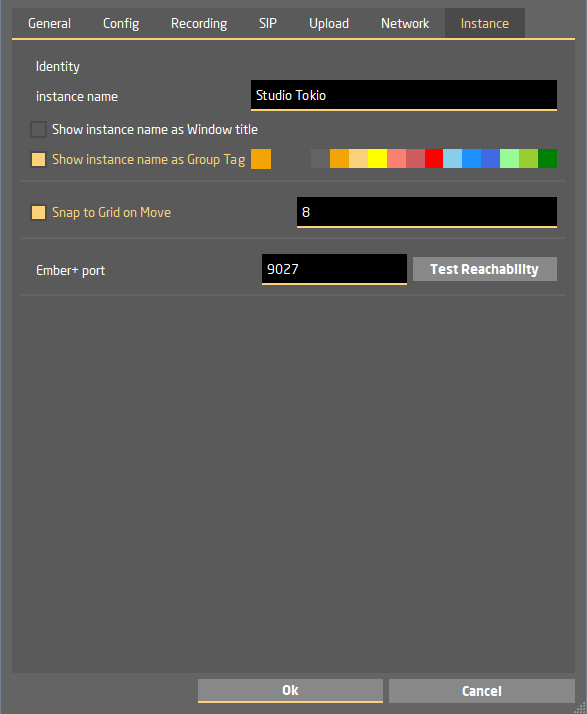This Options dialog is composed into several sections:
General
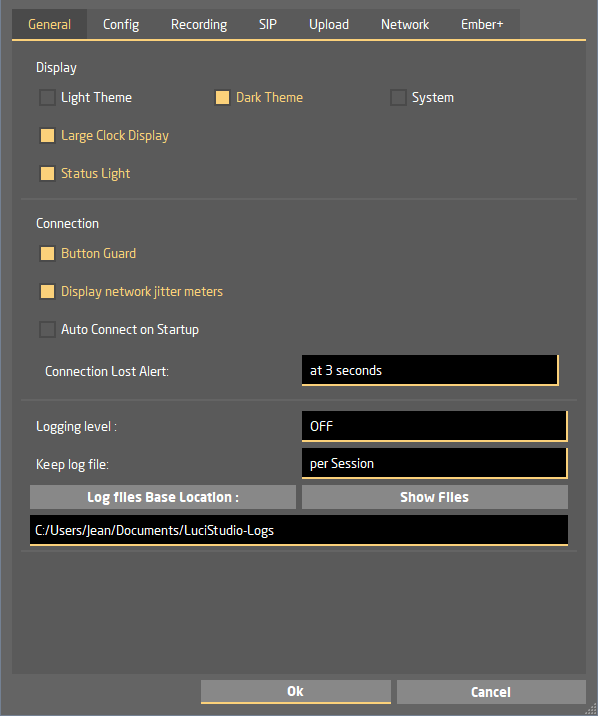
Themes
You can choose then color theme, either Light or Dark or a simple System theme
Large Clock Display
Adds a large clock on the main screen.
Status Light
When selected the background color of the main window will change according to the connection status (Gray = Unconnected, Blue = Connected, Orange = jitter close to tolerable value, Red = error, no incoming stream)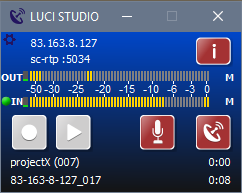

Button Guard
This will prevent disconnecting accidentally by means of a double check dialog.
Display network jitter meters
Display meters indicating the jitter on the displays IN stream and, if supported by the receiver, on the OUT stream.
Auto Connect on Startup
On checked LUCI STUDIO will be automatically connected at startup.
Connection Lost Alert
To get an audio signal when the connection is lost. Set it to OFF or to the number of seconds that the connection is lost.
Logging Level : Set Logging to OFF/CALLS/EVENTS/DETAILED, will create Log files in the Documents\LuciStudio-Logs\ directory ( press Show files to go there) This Base Location can be set. Here you can set LUCI Studio to log what it’s doing, for debugging purposes. If you experience any problems, set this to DETAILED and LUCI will write a *.csv file. Send this file to our support centre and also include your *.lsup so we can see what your settings are.
Keep log file : Set the timespan the log files will cover, so “per Session” will delete all previous sessions logs.
Log files are created in a special csv format with | as column separator and ‘ as text delimiter. You can set these at the import dialogue of your spreadsheet editor.
NOTE: Creation of Log files can slow down the PC or exhaust your drive. Use with care.
Config
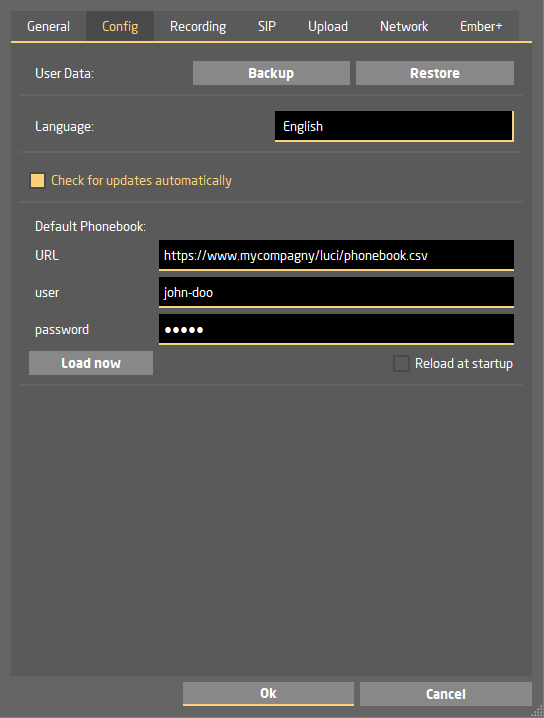
Backup/Restore User Data
You can save all of your License & Settings data to a compressed zip Archive, and restore it at will.
See section “Backup or Restore your Settings” for more detail.
Language : change the applications language to your preferred language
Check for updates automatically
It will alert you of an update and its changes.
Phonebook : With this function a CSV-formatted phonebook can be loaded automatically into your LUCI LIVE app from any internet location. As ‘Address’ fill in the URL where the file can be found, for example: luci.eu/example.csv
If the internet is a secure site also fill in the user and password to access the file. To load ( and test the url ) you can use Load now. If you always want an up to date phonebook check the Reload at startup option.
Recording
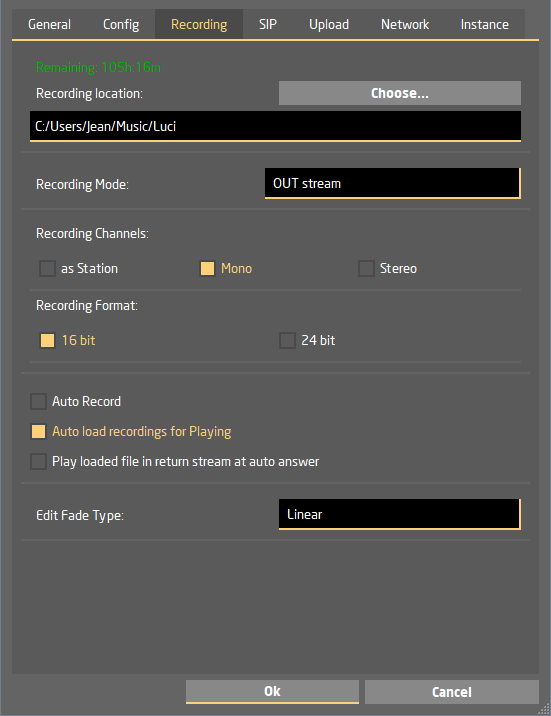
Default recording location : change the location where the recordings are stored on your device, or where to get the files for playing.
Recording Mode
Having 6 options, record only the direct audio input, the audio as send through the OUT stream, the audio received through the IN stream, or both mixed or in separate channels or seperate files ( .in and .out files ).
Recording Channels
Normally the mono/stereo for the recording file is the same as set in the stations profile, but you can set it differently here.
Recording Format
The bit quality is set ( Note that not all audio interfaces have 24 bit ).
Auto Record
Record every connection into a separate file.
Auto load recordings for Playing
If you enable this, a newly recorded file will be automatically loaded, ready to be played.
Play loaded file in return stream at auto answer
For playing a message to a newly connected person.
Edit Fade Type
Sets the editing slope to a preferred value.
SIP
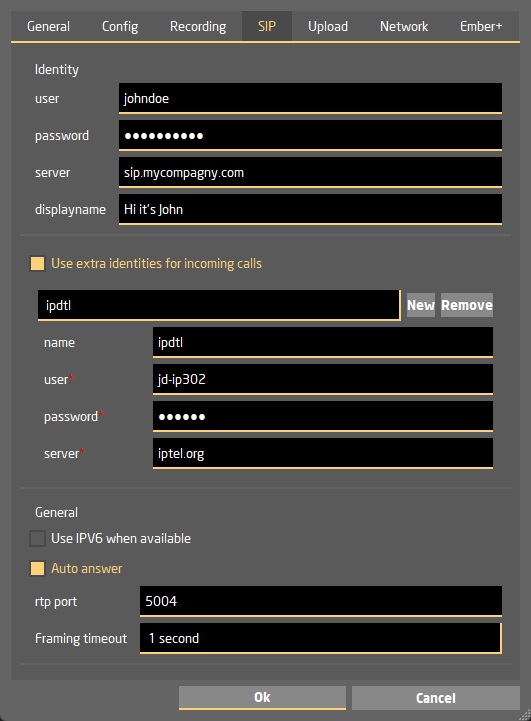 This submenu is used to setup general settings about your SIP connections. You can set one or more SIP identities, when connected the system will detect any incoming calls from all defined SIP servers. The first Identity is used as login when the Station profile setting “User Default” is checked.
This submenu is used to setup general settings about your SIP connections. You can set one or more SIP identities, when connected the system will detect any incoming calls from all defined SIP servers. The first Identity is used as login when the Station profile setting “User Default” is checked.
name
Fill in the name to identify it from the list
user
Fill in the username you use to log in at your server.
password
Fill in your password belonging to your username.
server
Fill in the address of the SIP server.
displayname
You can also fill in a name that will be shown to the callee.
Extra SIP identities can also be added, so you can handle calls from multiple SIP accounts. Please note that these have to be unique as these will be registered also.
New
Add a new empty entry.
Remove
Remove the current selected entry.
name
Fill in the name to identify it from the list.
user
Fill in the username you use to log in at your server.
password
Fill in your password belonging to your username.
server
Fill in the address of the SIP server.
Use IPV6 when available
LUCI is IPV6 compatible if your network supports it.
Auto answer
Check this option to automatically answer the incoming SIP call.
RTP port
Here you set the port to use for the RTP stream.
Upload
 To be able to send your audio file through FTP, please fill in the “URL” of your FTP server*, your “user” name and “password”. You can also enter your “reporter” and “organisation” name and “country code”.
To be able to send your audio file through FTP, please fill in the “URL” of your FTP server*, your “user” name and “password”. You can also enter your “reporter” and “organisation” name and “country code”.
You can define more FTP servers to be available, press “New” to create one and fill in the credentials. Press “Remove” to remove the selected FTP server.
*When using a “sFTP server” the URL needs to begin with “sftp://”
If you switch on FTP it will be shown as a publish options in the Tools menu, and in the ‘Edit’ screen.
Network
A separate window for network settings.
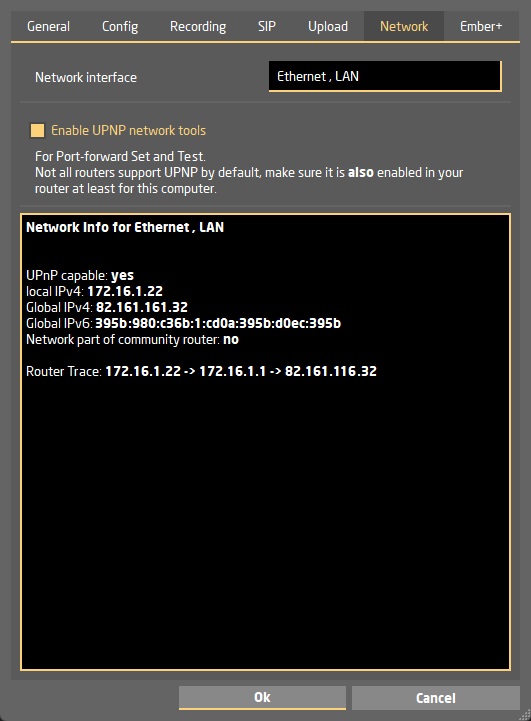
Network interface
Choose the network card you want to use (Default selects the Systems choice). Make sure the selected network interface is connected to the global internet.
Enable UPNP network tools
Universal Plug and Play (UPnP) is a set of networking protocols that permits networked devices, such as personal computers, printers, Internet gateways, Wi-Fi access points and mobile devices to seamlessly discover each other’s presence on the network and establish functional network services for data sharing, communications, and entertainment.
LUCI STUDIO can use UPNP to set a port-forward rule in your router, and determine more info about your network should there be a problem. The Network information is then displayed in the Network Info field.
NOTE: Not all routers support UPNP by default, make sure it is enabled in your router at least for this computer if you want to use this feature.
Network Info
When UPNP tools is enabled you can see if your router is UPNP capable, your local PC’s IP address, your Global Internet IP address and a complete trace from your PC to the Internet with all network ip translations.
Instance
When having licenses for more than one stream, every instance can be identified by giving it an unique “instance name”. 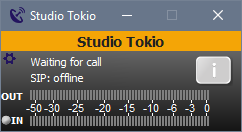 This name can then be shown as the Window title or as a special tag with a group colour. This is also the name shown in the LUCI STUDIO Manager.
This name can then be shown as the Window title or as a special tag with a group colour. This is also the name shown in the LUCI STUDIO Manager.
The value at “Snap grid on Move” is the number of LUCI STUDIO instances that are displayed on one row when the snap grid is enabled. The windows will “lock” in a grid and move together.
If licensed every LUCI STUDIO instance can be controlled by Ember+. To identify the instance it needs an unique “Ember+ port” number in your network for this instance of Luci Studio. Only if you want to control this Luci Studio from outside your network, it has to be TCP port-forwarded in your router ( see for more details our How To portforwarding but set it for TCP data). You can test this with the “Test Reachability”.
Note: This section is only available with the Ember+ plugin license.
